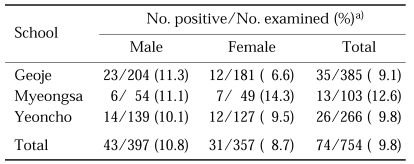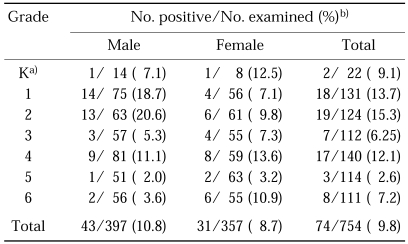Abstract
The status of pinworm (Enterobius vermicularis) egg positive rate of primary school children in Geoje island was investigated by using adhesive cellotape anal swap method, in September, 2002. Total egg positive rates of E. vermicularis were 9.8% (74/754) and those of male and female were 10.8% and 8.7%, respectively. Among three schools examined, Myeongsa primary school showed the highest egg positive rate (12.6%) followed by Yeoncho [9.8% (26/266)] and Geoje [9.1% (35/385)]. As for the age groups, the 2nd grade had the highest egg positive rate (15.3%), whereas the 5th grade showed the lowest egg positive rate (2.6%). The above result led us to confirm that the egg positive rates of E. vermicularis in primary school children in Geoje island were not significantly different from the those in the whole country including urban and rural areas, showing more than 10%.
Keywords: Enterobius vermicularis, egg positive rate, primary school children, Geoje island
The pinworm (Enterobius vermicularis) is distributed world-wide and the most common intestinal helminth of temperate regions. School children show particularly high infection rates, because of eggs containing invasive larva within a few hours of being laid and contact transmission. Neurological symptoms including anal itching sensation, nervousness, distraction and abdominal disturbance by enterobiasis (Beaver et al., 1984) influence the growth of children. Therefore, the adequate treatment and prevention are highly recommended.
Kim et al. (1991) reported that the egg positive rate of primary school children was 19.9% in Kangwon-do province, especially 61.9% among orphanage children and the egg positive rate of different regions such as urban and rural areas was significantly different (Im et al., 1986; Choi et al., 1987). The nationwide infection rate of E. vermicularis in Korea have apparently been reduced in comparison with the past (MHW and KAH, 1997). Recent reports, however, showed that the egg positive rate of primary school and pre-school children ranged between 10% and 20%. (Lee et al., 2000; Yoon et al., 2000; Lee et al., 2001; Kim et al., 2001) and significant difference of the egg positive rates of urban and rural areas was not found (Lee et al., 2001; Kim et al., 2001).
We performed this survey to investigate the hygiene of primary school children in Geoje island and to improve health by finding out E. vermicularis infection status performed adhesive cellotape anal swap were performed for total 754 children of three primary schools (Geoje, Myeongsa and Yeoncho) and kindergarten in Geoje island in September, 2002. Examination was done once in the morning. Educational facilities of three schools were similar to each other and the number of student of Myeongsa primary school was the smallest, compared with those of other two shcools. The result of examination showed that total egg positive rate was 9.8% (74/754) (Table 1). Myeongsa showed the highest positive rate (12.6%), followed by Geoje (9.8%) and Yeoncho (9.1%) (p > 0.05). Total egg positive rate of male was 10.8%, which was slightly higher than that of female (8.7%), however, the difference was not significant (p > 0.05). Egg positive rate of the 2nd grade was the highest (15.3%) and the 5th grade student was the lowest (2.6%) (p < 0.01) (Table 2). We found that the egg positive rate decreased as the grade moved up in agreement with the reports of Lee et al. (2001) and Kim et al. (2001). The 6th grade females revealed high egg positive rate (10.9%) but it seems to difficult to interpret this result because of small number of examined students (p > 0.05). Egg positive rates of male and female in kindergarten of Yeoncho were 7.1% and 12.5%, respectively.
Table 1.
Egg positive rate of Enterobius vermucularis in Geoje, Myeongsa and Yeoncho primary schools in Geoje island
a)Adhesive tape method was applied.
Table 2.
The status of egg positive rate of E. vermicularis by grades in primary schools in Geoje island
a)Kindergarten
b)Adhesive tape method was applied.
In the present study we confirmed that the infection rate of E. vermicularis of primary school children of Geoje island was not greatly different from that of entire country. In our previous study, we pointed out that the number of students per class might influence egg positive rate of E. vermicularis (Kim et al., 2001). In the present study, however, the school showing the highest positive rate was Myeongsa which has the lowest number of students per class. Therefore, these results led us to conclude that other factors could affect egg positive rate, besides the number of students per class. Treatment of the positive and their family was performed with the support of Public Health Center of Geoje island. Nevertheless, complete eradication of enterobiasis has been found to be difficult and reinfection is frequent (Yang et al., 1997). Kim et al. (1991) suggested that mass screening and medication is effective for eradication of enterobiasis. Therefore, periodic examination together with adequate medication will be helpful to reduce enterobiasis of primary school children.
References
- 1.Beaver PC, Jung RC, Cupp EW. Clinical parasitology. 9th ed. Philadelphia, USA: Lea & Febiger; 1984. pp. 302–306. [Google Scholar]
- 2.Kim JS, Lee HY, Ahn YK. Prevalence of Enterobius vermicularis infection and preventive effects of mass treatment among children in rural and urban areas, and children in orphanages. Korean J Parasitol. 1991;29:235–243. doi: 10.3347/kjp.1991.29.3.235. [DOI] [PubMed] [Google Scholar]
- 3.Kim BJ, Yeon JW, Ock MS. Infection rates of Enterobius vermicularis and Clonorchis sinensis of primary school children in Hamyang-gun, Gyeongsangnam-do (province), Korea. Korean J Parasitol. 2001;39:323–325. doi: 10.3347/kjp.2001.39.4.323. [DOI] [PMC free article] [PubMed] [Google Scholar]
- 4.Lee KJ, Ahn YK, Ryang YS. Enterobius vermicularis egg positive rates in primary school children in Gangwon-do (province), Korea. Korean J Parasitol. 2001;39:327–328. doi: 10.3347/kjp.2001.39.4.327. [DOI] [PMC free article] [PubMed] [Google Scholar]
- 5.Lee KJ, Lee IY, Im K. Enterobius vermicularis egg positive rate in a primary school in Chungchongnam-do (province) in Korea. Korean J Parasitol. 2000;38:177–178. doi: 10.3347/kjp.2000.38.3.177. [DOI] [PMC free article] [PubMed] [Google Scholar]
- 6.Ministry of Health and Welfare, Korea Association of Health, Republic of Korea. Prevalence of intestinal parasitic infections in Korea. The 6th report. Seoul, Korea: 1997. [Google Scholar]
- 7.Yang YS, Kim SW, Jung SH, Huh S, Lee JH. Chemotherapeutic trial to control enterobiasis in schoolchildren. Korean J Parasitol. 1997;35:265–269. doi: 10.3347/kjp.1997.35.4.265. [DOI] [PubMed] [Google Scholar]
- 8.Yoon HJ, Choi YJ, Lee SU, Park HY, Huh S, Yang YS. Enterobius vermicularis egg positive rate of pre-school children in Chunchon, Korea (1999) Korean J Parasitol. 2000;38:279–281. doi: 10.3347/kjp.2000.38.4.279. [DOI] [PMC free article] [PubMed] [Google Scholar]




